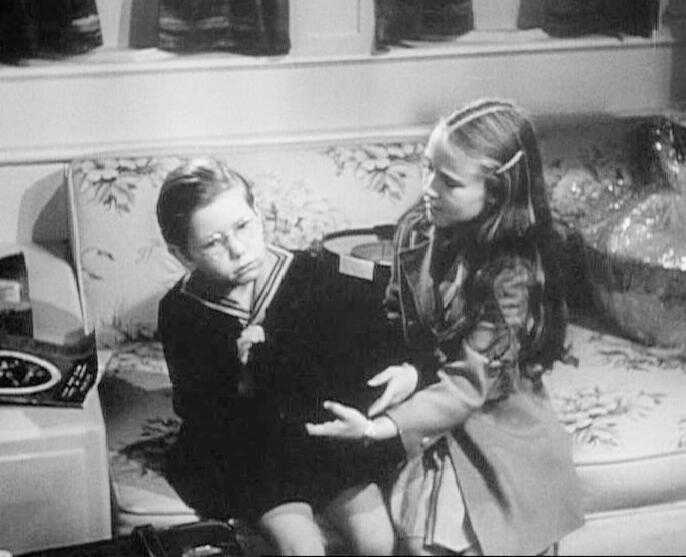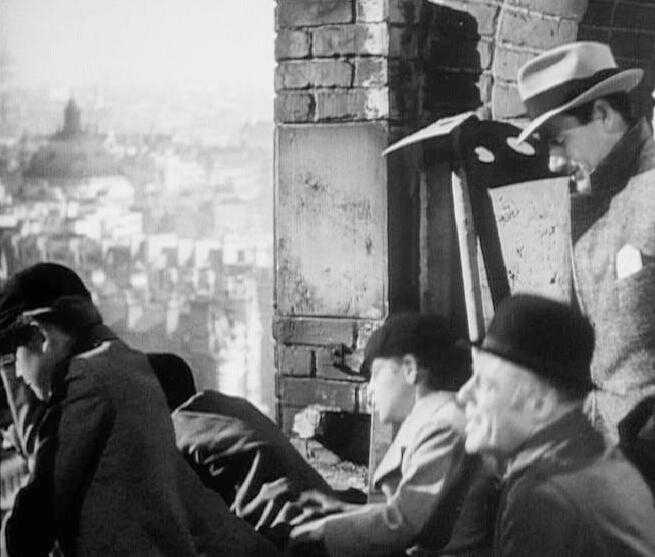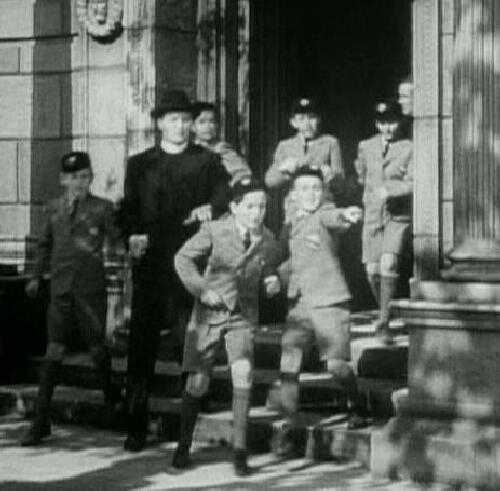
Foreign Correspondent - (United States, 1940)

Figure 1.--The boy with wearing the sailor suit here is Jones' (Haverstock's) little brother. It is very early in the film when Jones is departing for Europe on the "Queen Mary". His family have come to see him off. He bought a new hat which he gave to his little brother to hold. Some how the hat was not given back. The little vrother was delighted to have his older brother forget the new hat. Once the "Queen Mary" leaves New York Jones' family are not mentioned again.
|
|
This is a World War II spy thriller made by Alfred Hitchcock. Near the beginning the hero's family sees him off to Europe. A little fellow, presumably a younger brother appears in short shorts and mischiviously nabs his hat. Later during a scene in a tower the correspondent is about to be pushed to his death a school group shows up. The boys att wears dark caps and presumablyh grey short pants suits. The shorts are very long as was the style then. At the end Hollywood makes an appeal to America. The American foreign correspondent is making a broadcast with the Luftwaffe makes another raid on London. When the lights go out in the studio he describes the lights going out all over the world, only in America were the lights on. The correspondent urges American to build more guns, tanks, planes, and battleships. Sounds hokey today, but it wasn't at the time. In actuality, American correspondents in Europe, especially Edward R. Murrow and his vbrodcasts during the Blitz, played a major in changing the isolationists views of most Americans.
Filmography
"Foreign Correspondent" was a spy thriller made by thrill-master Alfred Hitchcock. It was released by United Artists. This was his second film after he came to America. The first was "Rebecca" (1940). David O. Selznick farmed him out to independent producer Walter Wanger. This film still has the feel of his earlier English films "The 39 Steps" (1935) and "The Lady Vanishes" (1937). The original screenplay was based on Vincent Sheean's autobiographical memoir, Personal History. Perhaps because of the tramatic developments in Europe (the Fall of France and the Blitz), the film diverges from the book. In the end the film uses an original screenplay with an entirely different plot. The screenplay was written by Charles Bennett and Joan Harrison. Popular novelist James Hilton and Robert Benchley as well as uncredited scriptwriters added dialog. The fiolm was dominated for several accademy awards, but did not receive any.
Setting
The film is set in the Netherlands and England (London). I'm not sure where it was actually shot. Given the military situation, I assume it was shot in America. Thus the uniformned British schoolboys must have been American boys. I can't recall now their accents.
Cast
The stars were Joel McCrea and Laraine Day. They were not Hitchcock's first choice. The most interesting character is surely the assassin Rowley played by mild-mannered Edmund Gwenn. I'm unsure who the children dressed in school uniforms were.
Film Making
The special effects in several scenes here, especially the clipper crash, seem hokey today. Special effects are today so spectacular and such an important element in modern films, that the rather primitive special effects in early films are almost laughable. Unfortunately this probably further reduces the market for these wonderful black and white film. It should be remembered that this film was at the time a well-received spy thriller.

Figure 2.--This is the scene in the bell tower wherec Rowley tries to kill Jones. Before the assassin can carry out his attack, a group of school boys arrives on the observation deck. Click on the image to see Rowley helping one of the boys to get a better view.
|
|
Plot
This film is about an American crime reporter Johnnie Jones (Joel McCrea) operating with the pseudonym Huntley Haverstock. Jones is working in Europe just as World War II is erupting. He is aggressive, but naive and has no real international experience. He is used by a NAZXI spy ring masquerading as a peace organization.
He sees a faked assassination of Dutch diplomat Mr. Van Meer (Albert Bassermann) on the stairs of the Amsterdam Town Hall. Thge assassin is disguised as a newspaper photographer and concealed a gun in his camera. Jones persues him through rainy Amsterdam and a mass of black umbrellas. While still in the Netherlands there is a windmill scene in which he learns about the spy ring that has kidnapped and tortured the real Van Meer. Jones then goes to London where he assumes he is safe. He now knows too much and is targetted by the spy ring. Jones is hot on the trail of spies. They plan to asassinate him. They pick a British hit man--Rowley. He takes Jones to the observation deck of Westminster Tower in London from where he plans to push him off so that he will fall to his death. The episode is made all the more chilling by the choice of the assassin. Rowley is played by the mild mannered Edmund Gwenn and is set among a group of school boys also visiting the tower. Aftter all if Gwenn can be a NAZI spy and assassin, who can you trust. Rowley and Jones get to the top of the tower. Unfortunately there is a party of school boys there preventing the Assassin from carrying out his assignment. The assassin appears a kindly old man. A small boys says he can't see. The assassin picks him up and holds him over the parapet. This is a scary scene because you wonder if he will let the boy fall to his death. All that happens is that the boy's school cap falls off. The boys go down and the assassin sees his chance but at the last moment Haverstock turns and sees the assassin coming. He steps out of the way and the assassin falls to his death and with a typical Hitchcock flourish while the Requiem Mass being chanted in the cathedral. The school boys arrive outside the tower to witness the fall. They are heading towards the accident scene as are members of the general public. The school teachers calls them back and directs them away from the accident. There is another dramatic scene, the crash of the trans-oceanic clipper airplane headed for America. A few survivors make it out to the wing. Jones returns to to London. There he experiences the Blitz. At the end of the film during a NAZI air raid he appeals to Americans to drop their neutrality and join Britain in fighting the NAZIs. He tells Americans, "It's death coming to London...It's too late to do anything here now except stand in the dark and let them come. It's as if the lights were all out everywhere, except in America. Keep those lights burning there! Cover them with steel! Ring them with guns! Build a canopy of battleships and bombing planes around them! Hello, America! Hang on to your lights. They're the only lights left in the world."
Foreign Correspondents
The title "Foreign Correspondent" would have had a special ressonance with Amnericans in 1940. Some of the men who would become some of America's most important journalists were in Europe reporting on events froim the Anchluss through the Battle of Britain. Many were highly educated and spoke foreign languages. Unlike Jones in the film, there were not naive. American correspondents in Europe, especially Edward R. Murrow and his brodcasts during the Blitz. They did not make such overt pleas for America to intervene, but they did play a major in changing the isolationists views of most Americans.
Costuming
Near the beginning the hero's family sees him off to Europe. A little fellow, presumably a younger brother appears in short shorts and mischiviously nabs his hat. Later when the corresponsent is back in London there is a scene in the Westminister bell tower the correspondent is about to be pushed to his death a school group shows up. The boys att wears dark caps and grey short pants suits. The shorts are very long as was the style then. This would mean they were from a private school.

Figure 3.--Here are the boys at the base of the tower after the failed attempt to murder Jones.
|
|
The most interesting aspect of this film is the political context. At the end Hollywood makes an appeal to America. The American foreign correspondent is making a broadcast with the Luftwaffe makes another raid on London. When the lights go out in the studio he describes the lights going out all over the world, only in America were the lights on. The correspondent urges American to build more guns, tanks, planes, and battleships. Sounds hokey today, but it wasn't at the time. Actually look back on it, it is rather startling that a foreigner would be allowed to make such a strong plea for America to enter the War. Esprecially because President Roosevelt at the time was assuring Americans that we would not go to war unless attacked. Hitchcock's message while perhaps stronger than other films, was not essebtially different than other Hollywood films made during 1939-41 befofe America entered the War. The quite amazing fact is even though isolationiost sentiment was very strong in America, I don't know of one Hollywood movie made during this period that had an isolationist message.
German Fan
In the midst of the disaster on the Eastern front, German Propaganda Minister Josef Goebbels, took time to see the film. Film making was one of Goebbels favorite activities and he judged himself an insightful film critic. In his diary after describing the transports from the East full of wounded soldiers, Goebbels shifts to the film indudtry. First he pats himself on the back, "Movie production is flourishing almost unbelievably despite the war. What a good idea of mine it was to have taken possession of the films on behalf of the Reich several years ago! It would be terrible if the high profits now being earned by the motion-picture industry were to flow in private hands." [January 22, 1942--Goebbels, p. 38.] It is of course telling that he would write this in the same daily entry of his diary that he described the transports full of wounded soldiers. It speaks volumes as to his character. Then he goes on to describe this film. "I saw the new American propaganda movie, "The Foreign Corresondent". It is a first-class production, a criminological bang-up hit, which no doubt will make a certain impression upon the broad masses of the people in enemy countries. Significantly enough this film, with its absolutely anti-German tendency, was allowed to run for months in Sweden. The Swedes and the Swiss are playing with fire. Let us hope they will burn their fingers before this war is over." Of course the disaster on the eastern Front was beginning to change the balance of power and the ability of the NAZIs to control events.
Sources
Goebbels, Joseph. ed, Louis B. Lochner, The Goebbels Diaries, 1942-1943 (Doubleday: New York, 1948), p. 566.
HBC

Navigate the Boys' Historical Clothing Web Site:
[Return to the Main Fm-Fz page]
[Introduction]
[Activities]
[Biographies]
[Chronology]
[Clothing styles]
[Countries]
[Topics]
[Bibliographies]
[Contributions]
[FAQs]
[Glossaries]
[Images]
[Links]
[Registration]
[Tools]
[Boys' Clothing Home]
Created: 5:31 AM 10/29/2004
Last updated: 5:42 PM 8/1/2008





